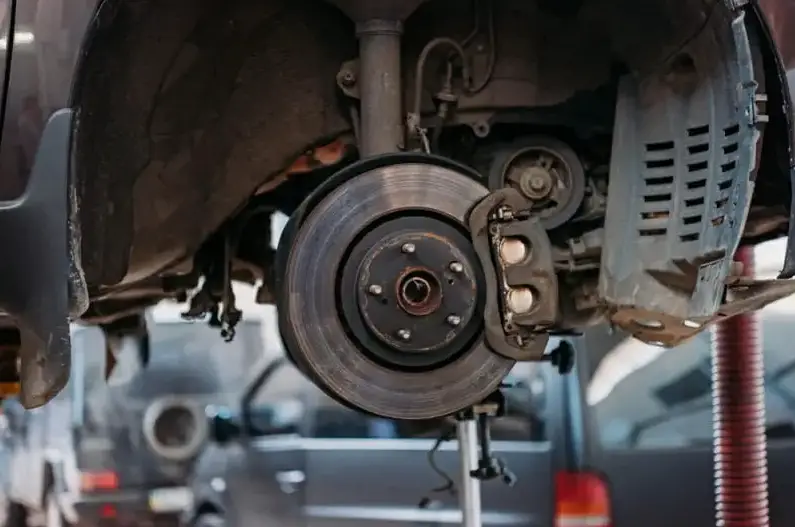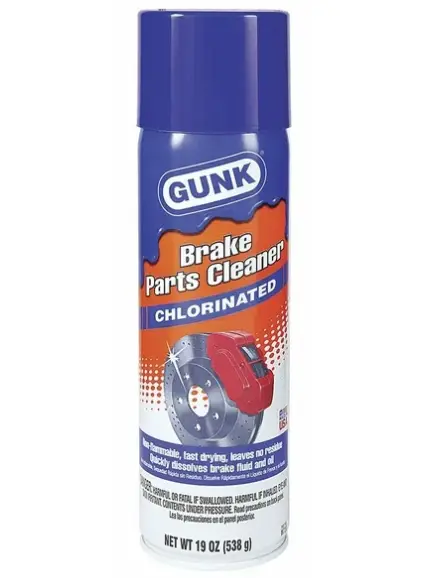Is brake cleaner flammable? Yes, especially non-chlorinated types, which can easily ignite near heat or flames. Chlorinated versions are less flammable but release toxic fumes when heated. Always use with caution.
Brake cleaner is a staple in every mechanic’s arsenal. It’s fast, effective, and makes the job easier by removing brake dust, oil, grease, and other contaminants. But one question that often sparks debate and concern is: “Is brake cleaner flammable?”
This isn’t just a matter of curiosity—knowing the flammability of brake cleaner can prevent serious injuries, property damage, and even death. In this article, we’ll break down the different types of brake cleaner, their chemical compositions, how they behave under heat, and what you can do to use them safely.

Contents
Brake Cleaner: What’s in It?
Brake cleaners come in two major formulations:
- Chlorinated Brake Cleaners
- Non-Chlorinated Brake Cleaners
Chlorinated Brake Cleaner
These cleaners typically contain perchloroethylene (perc) or methylene chloride, both of which are not flammable under normal conditions. However, that doesn’t mean they are entirely safe.
Characteristics:
- High solvency power
- Non-flammable under typical conditions
- Leaves minimal residue
- Slower evaporation rate
Hazards:
- Toxic fumes when heated: Chlorinated brake cleaners can form phosgene gas, a deadly compound used in chemical warfare during World War I, when exposed to open flame or high heat (such as welding or torching).
- Long-term exposure can affect the liver, kidneys, and nervous system
- Banned or restricted in many regions due to environmental concerns (especially with VOC emissions)
So, while not flammable, chlorinated cleaners pose serious health and chemical risks, especially in high-temperature situations.
Non-Chlorinated Brake Cleaners
Non-chlorinated brake cleaners are often considered “safer” because they lack the harsh toxins of their chlorinated counterparts. But ironically, they are significantly more flammable.
Common Ingredients:
- Heptane
- Acetone
- Toluene
- n-Hexane
These are volatile organic compounds (VOCs) that evaporate quickly and have low flash points (the temperature at which a liquid gives off vapors that can ignite).
Characteristics:
- Highly flammable
- Fast-drying
- Safer in terms of toxicity
- More environmentally compliant
Hazards:
- Can easily ignite from sparks, static electricity, or open flames
- Flashback fires (when vapor travels to an ignition source and causes fire to trace back to the spray can)
- Risk of burns or explosions if used near heat sources
Bottom line: Non-chlorinated brake cleaners are flammable. Handle with extreme care.
Real-World Examples of Brake Cleaner Fires
Brake cleaner is a go-to product for removing grease and grime from brake components—but it’s also highly flammable. When misused or exposed to heat sources, it can ignite quickly, leading to dangerous fires or explosions. Here are some real-life examples that highlight just how serious the risks can be:
1. Flame Flashback from a Nearby Spark
Incident: A DIY mechanic was using brake cleaner to prep a caliper for painting. After spraying, he picked up a power tool to grind rust nearby.
What happened: The grinder sparked, igniting lingering brake cleaner vapors. A flash fire spread across the workbench in seconds, burning tools and causing second-degree burns on his arm.
Lesson: Always allow brake cleaner to fully evaporate—and never use it near open sparks or flames.
2. Brake Cleaner and Welding: A Toxic Explosion
Incident: The welder ignited the surface, unaware that brake cleaner residue remained. The heat caused the brake cleaner (especially chlorinated variants) to decompose and release phosgene gas—a highly toxic substance used in chemical warfare.
Result: The technician inhaled the gas and was hospitalized with serious respiratory damage. Although he survived, he suffered long-term lung sensitivity and required weeks of recovery.
Lesson: Never weld or torch-clean any surface that has had brake cleaner applied, especially chlorinated types. Even a small amount of residue can turn deadly under extreme heat.
3. Hot Exhaust Ignites Under-Car Spray
Incident: A car enthusiast sprayed brake cleaner onto a control arm near the exhaust system, thinking the car had cooled enough.
What happened: The exhaust was still hot, and the residual vapors instantly ignited. Flames shot up under the vehicle, burning wiring and fuel lines before the fire could be extinguished.
Damage: The vehicle sustained over $3,000 in fire damage. The owner was uninjured but shaken.
Lesson: Always check that components are fully cooled before spraying flammable cleaners. Brake cleaner vapors are heavier than air and can linger in tight spaces like undercarriages.
4. Brake Cleaner + Open Flame = Shop Fire
Incident: In a small repair shop, a technician sprayed brake cleaner near an open propane space heater.
What happened: The invisible vapors drifted toward the flame and ignited, creating a fireball that quickly engulfed the corner of the shop.
Outcome: Firefighters responded, and no one was seriously injured—but the shop was shut down for weeks and suffered significant property loss.
Lesson: Keep all flammable chemicals away from open flames and ignition sources, even across the room. Vapors can travel and ignite unpredictably.

Safety Guidelines: How to Use Brake Cleaner Safely
Whether you’re using chlorinated or non-chlorinated cleaner, safety is non-negotiable. Here’s how to minimize risk:
Always Read the Label
Manufacturers are required to list flammability warnings. Look for:
- Flash point temperatures
- “Extremely Flammable” or “Not for use near flames” markings
- VOC content
Use in Well-Ventilated Areas
Brake cleaner vapors can accumulate and form flammable or toxic concentrations in poorly ventilated spaces. Use fans or exhaust systems when working indoors.
Store Away from Heat
Brake cleaner cans should be stored below 120°F (49°C) and away from:
- Sunlight
- Electrical tools
- Water heaters or furnaces
Never Use Near Welding or Open Flames
Even if the surface appears dry, residual vapors may linger. Avoid:
- Welding
- Grinding
- Soldering
- Torch cutting
Use Personal Protective Equipment (PPE)
- Chemical-resistant gloves (nitrile or neoprene)
- Safety goggles or face shield
- Respirator (if working in tight or poorly ventilated spaces)
Read more about How to Use Brake Cleaner.
Environmental and Legal Considerations
Due to their VOC content and toxic byproducts, many brake cleaners are subject to environmental regulation.
United States (EPA)
- Limits VOC content in brake cleaners
- Bans certain chlorinated solvents in some states (e.g., California)
European Union (REACH Directive)
- Requires labeling of carcinogenic or mutagenic substances
- Restricts use of trichloroethylene in industrial products
Safer Alternatives
Some companies now offer water-based or citrus-based cleaners, which are non-flammable and biodegradable. While not as strong, they’re ideal for light-duty cleaning and safer work environments.
Frequently Asked Questions
Here are some FAQs about brake cleaner flammability –
Q1: Can I spray brake cleaner on hot brake parts?
A1: It’s not recommended. Spraying on hot parts can cause rapid evaporation and possibly ignition if the cleaner is flammable.
Q2: Will brake cleaner catch fire if exposed to a lighter or torch?
A2: Non-chlorinated cleaner will ignite easily. Chlorinated cleaner might not ignite, but it will release toxic gases like phosgene when heated.
Q3: Is it safe to use brake cleaner as a general-purpose degreaser?
A3: It can be, but only if the surface is cool and well-ventilated. For broader cleaning needs, consider purpose-built degreasers.
Q4: What happens if I inhale brake cleaner fumes
A4: Short-term exposure can cause dizziness, nausea, or headaches. Long-term exposure (especially to chlorinated types) may damage the central nervous system or organs.
Q5: Are there brake cleaners that are completely non-flammable?
A5: Chlorinated cleaners are technically non-flammable, but they are dangerous in other ways. Water-based alternatives offer true non-flammability but lack heavy-duty power.
Conclusion
Brake cleaner may seem like just another can on the shelf, but it’s a high-risk tool when used without caution. While chlorinated versions are less flammable, they come with their own health risks. On the other hand, non-chlorinated brake cleaners can easily ignite, making them dangerous around heat sources.
If you’re a DIY enthusiast, technician, or shop owner, knowing the properties of what you’re working with can protect not only your project—but your life.
Final Tip: When in doubt, treat all brake cleaners as hazardous. Ventilate, protect, and always read the label.